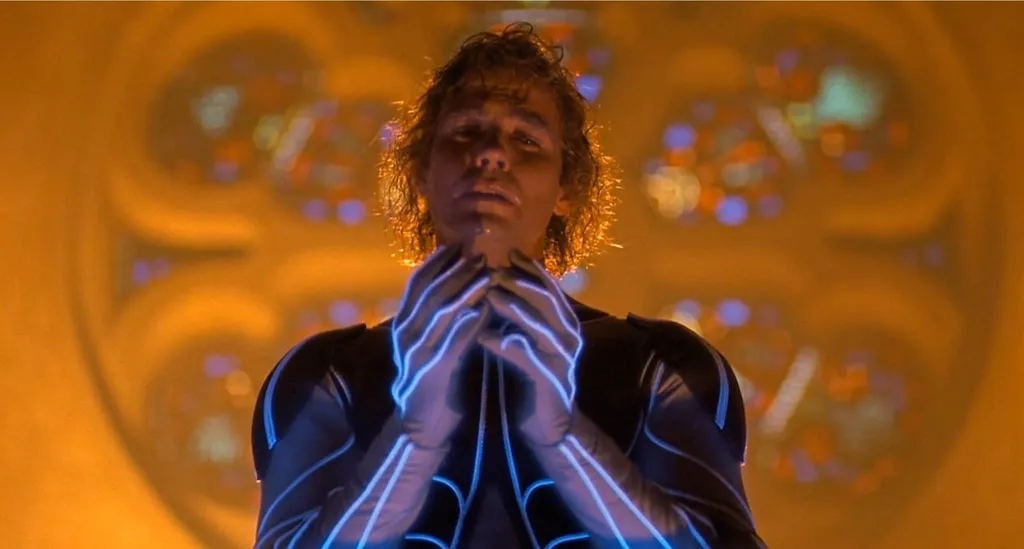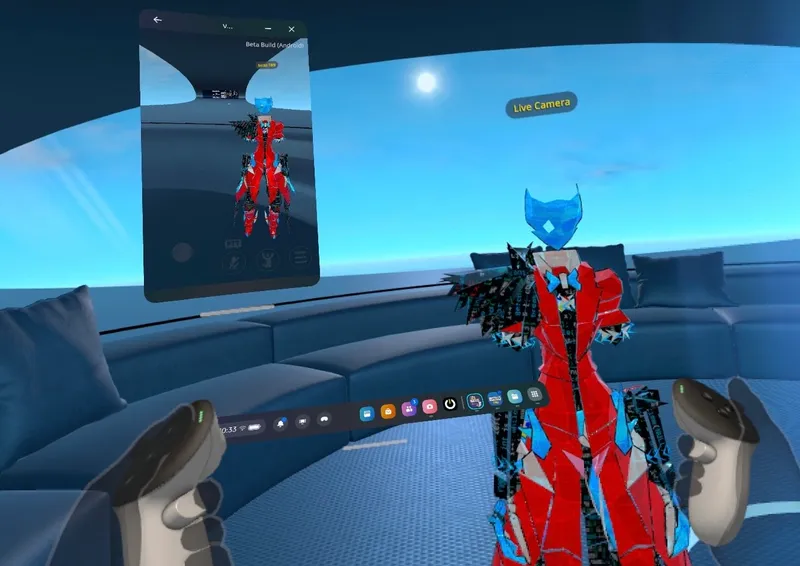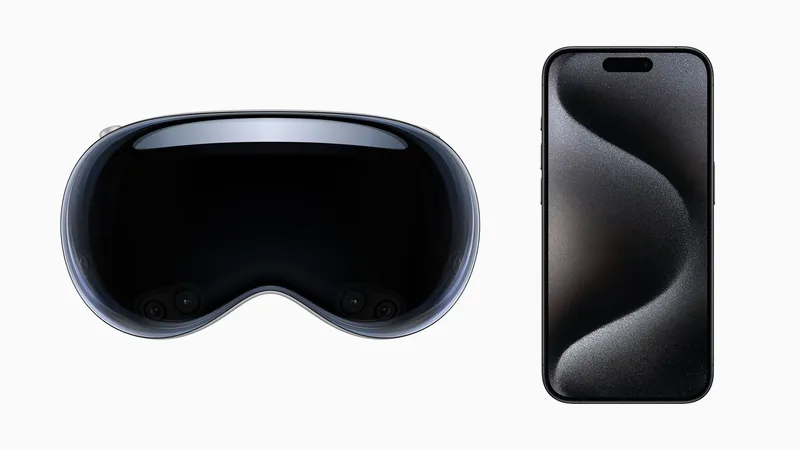Writers have speculated about virtual reality and augmented reality for decades. We take a look at how close film and television of the past got to the actual tech that exists today.
We have all watched the scene in countless films before: our protagonist pulls on “VR goggles” and is transported to a complete world with perfect representation of the character’s body, delivering full immersion. When I saw this as a kid in various movies or tv shows, I immediately knew I wanted that experience. I wanted to enter a world where I can enjoy the exhilaration of flight or engage in a Wild West adventure.
We can see these moments now and know how much Hollywood companies have exaggerated virtual reality gaming or augmented reality capabilities. But for all those that got it wrong, there are those that got it right. So let’s take a look at the most notable of examples both–and I will try to keep to only minor spoilers.
Hollywood VR: What They Got Right
There are older films with VR, but Lawnmower Man may have been the one that people point to as the “VR movie.” Released in 1992, we have a scientist played by Pierce Prosnan using VR and questionable pharmaceuticals to make Jeff Fahey smarter–and eventually into a psychotic, technological god.
Though the early CGI feels dated, it still works through the lens of a game’s specific graphic style. There are early scenes of characters playing games with just headsets, and later VR use in a lab with full haptic suits in rigs that suspend them in air for three-dimensional movement. Yes, there is some exaggeration, but this feels like a glimpse of what VR actually can be like these days and in the near future.
A 1999 film that dives into a virtual world is Existenz, from cult director David Cronenberg. We follow Jude Law and Jennifer Jason Leigh as they explore a VR game created procedurally through the minds and intentions of everyone playing the game.
At times the film is more bizarre and atmospheric than story-based, but the use of actual video game conventions such as NPCs and breadcrumbs in questlines gives it an air of authenticity. Ultimately, this is our first example of VR somehow instigating reality immersion to the point that someone forgets their identity and real world, but it is played here ambiguously to great effect.
No discussion of virtual reality representation on screen wouldn’t be complete without mentioning scifi anthology series Black Mirror. Episodes of note include the augmented reality horror story Playtest, which gives a realistic take on what AR gaming will look like before it veers into mind games. Then there is Striking Vipers, which takes on the wish fulfillment of VR and relationships not restrained by reality.
But the most famous of the anthology’s stories would be San Junipero, the award-winning episode about virtual worlds based in different decades of our history, and one couple’s rocky courting there. Yes, it features the exaggeration of sending your mind into a virtual reality, rather than using actual VR tech, but the sense of virtual travel and social interaction rings true.
(Content Warning: adult language)
Another recent example of VR done right in a TV series is the British show Kiss Me First from 2018, about a group of friends in a VR MMO whose manipulations by one of the members takes a deadly turn. The show features some DIY headsets and haptic gloves, with visible wires and chips, as well as high-end futuristic looking gear.
Once again, the translation of people into virtual reality is too realistic, movements too fluid, but the stylized CG is spot on. As is the social dynamics of virtual friends and all the pitfalls that can result as compared to friendships in the real world.
No list of films that get this tech right wouldn’t be complete without touching on the best use of augmented reality in film. Spielberg’s scifi action flick Minority Report may be from 2002, but it is prophetic about the UI and motion controls of an AR computer system. Tom Cruise gestures and explores files, physically move windows from a tablet to a PC, interactions that give us a glimpse of what is becoming possible through our own motion controls and virtual offices.
https://www.youtube.com/watch?v=PJqbivkm0Ms
There are other great pieces to talk about that also touch on VR and AR. There are the representations of AR operating systems in a diversity of films throughout the last 40 years, from Terminator, to Robocop, to Iron Man.
There are also warnings about VR tech out of control, such as the violent game of indie film Avalon from director Mamoru Oshii or the noir film Thirteenth Floor or the conspiracy plot of cult anime show Serial Experiments: Lain.
And there is the fun kids movie Spy Kids 3D that embraces video gaming in VR or cerebral TV series Caprica, which carefully explores the social ramifications of a virtual world.
What They Got Wrong
There are almost too many examples of films and shows that got virtual and augmented reality incorrect, but here are some that are indicative of the ways they usually miss the mark. These are usually entertaining films where the writers and directors didn’t let the reality of VR get in the way of their storytelling.
A Michael Douglas drama from 1994 called Disclosure had VR. It is mostly about sexual harassment and corporate maneuvering, but in one scene our protagonist uses a VR prototype to access the company’s private records. Now, the headset is tethered, the motion control glove looks believable, and he is standing on a motion detection platform.
From the equipment to the first-person POV shots, it looks believable. But this isn’t how people use VR. No one is going to walk down a huge hallway just to access a file. Shot after shot of Douglas traveling through a green screen set feels ridiculous. And who connects a live company database to prototype tech they are demoing to the public?
Another trope that continuously comes into play with stories involving VR is people getting lost in it, to the point that their identity or real life is forgotten. The previously mentioned Existenz tiptoes on this line, but there are many other films that are really guilty of this. In 1990’s Total Recall, we are not sure if Arnold Schwarzenegger is actually on Mars, or taking a virtual vacation.
Characters try to convince him it is virtual, and not real, but the logic of how he deduces the truth is a bit iffy–especially when the last moments of the film he himself once again brings up that it all may be virtual. Inception, the 2010 masterpiece, also ends on a similar note of uncertainty. Of course, actual virtual reality will likely never get to the point that it subverts your brain functions to the point where you do not remember who you are or what your real life is actually like.
Speaking of Inception, another plot that comes up again and again is entering the virtual world of someone’s mind. I suppose this may technically not be VR technology, but it is often portrayed that way in the shows and films. The fore-mentioned Inception is guilty of this, but so are older films like Brainstorm (1983) and Dreamscape (1984).
The best example of this may be the cult-TV show VR.5 (1995). A tiny show that was canceled after one season, but gained a following for the technology-driven plot and interesting characters. The story involves the mysterious death of an inventor of VR, and his computer-savvy daughter investigating his murder, and also helping others, via VR that let’s you enter people’s minds. (Trigger warning for the video below, for both the ’90s cheesiness and sexual assault depiction.)
Attention should also be paid to The Matrix, probably the most popular and influential film on this list. This 1999 scifi action film from the Wachowskis became a huge part of our zeitgeist. The directors wanted to show the crazy action of an anime in live action form, and used the setting of a virtual world that humanity is trapped inside as a means to do so.
This is not only a case of my earlier subject of people not knowing the real world, but it supposes technology even more advanced in the way it interfaces a person with technology. Not only do you experience a world and life identical to the senses as the real one, it treats the human brain as software, where you can just upload skills, manipulate the body, or even be infected by a computer virus. It remains to be seen if the upcoming Matrix 4 will be more true to real-life VR.
Other honorable mentions include examples as diverse as action film Gamer, where people control other people using tech similar to VR, animated masterpiece Paprika, where people enter and manipulate others’ dreams, Upload, the streaming dramedy where the minds of dead people are transported to virtual worlds, the obscure-but-ahead-of-its-time show Profit which unfortunately used VR in boring, corporate ways, and a mediocre thriller named Virtuosity, where an evil VR artificial intelligence gets a nanotech body and goes on a killing spree, but the VR is barely utilized except as a way to present an AI in the beginning.
What the Future May Hold
There are two works that afford a special mention, two notions of virtual reality that have proven more influential than others, and still may be possible in the future.
Star Trek: The Next Generation debuted in 1987, a second series that follows up the classic scifi program of the ’60s. One of the new features that this future version of the starship Enterprise had was the holodeck, a programmable room that you walked around in and, through the use of solid holograms, tricked your senses. It introduced millions of people to the concept of technologies that can take you to other worlds. When the Vive headset, with its room-tracking capabilities from Valve’s Lighthouse sensors, came out in 2016 it was continuously compared to a holodeck. It is still quite possible, whether through haptic clothes or other technology, we will get a technology where you can walk around a room and things touch you back, interacting with a world physically and not just seeing and hearing it.
A more recent work that has changed the course of virtual reality is the 2011 book and 2018 film by the same name, Ready Player One, from Ernest Cline. In this possible future of 2045, a virtual reality platform called the OASIS has supplanted the Internet as the most important technology. People go to work in VR, go to school in VR, and, obviously, play games in VR. While not being high art, the book’s full embrace of ’80s culture and games, and the concept of a virtual world where you can see anything and be anyone, resonated.
Oculus once gave the book to every employee, and as well as all attendees of their Oculus Connect conference. The recent film version and the newly released sequel may not be the blockbusters that the original was, but it may still be significant to VR: will virtual reality ever become as ubiquitous as OASIS, touching every aspect of our lives? Considering the Internet and cellphone technology’s spread, it is certainly possible.
There are some other books of note that inspired VR and may continue to effect future tech. The cyberpunk works of William Gibson from the ’80s and ’90s feature technology becoming completely tangled in people’s lives, including coining the term of Cyberspace. His later books show an augmented reality future, a level of hologram marketing and interactions on top of the real world. Neal Stephenson’s 1992 novel Snowcrash includes the appearance of the Metaverse, a term still used today by VR fandom to signify a virtual social world that everyone connects to.
And I would be remiss to mention cult series Otherland by Tad Williams, a four-book series published from 1996 to 2001. It is a conspiracy thriller through various virtual worlds based on such diverse subjects such as Alice in Wonderland, the Illiad, and World War I. It even inspired a Steam-based MMO in 2015.
It is clear from decades of work, that Hollywood, and writers in general, are enamored with virtual reality and augmented reality. Concepts of future tech have always inspired creators to weave stories that use technology, whether just for light entertainment, or for deep dramas that use virtual worlds to hold up a mirror to our actual world. This will likely continue as the popularity of VR seems to be increasing with the higher sales of each new Oculus headset, the cutting edge capabilities of each new PC headsets, and the possibilities afforded by upcoming AR headsets.
Perhaps one day we will even see true-to-life VR use on Law and Order or some other paint-by-numbers TV show. But that just may be a fantasy.
Let us know other TV shows or movies you’ve seen that depict VR and what you thought about the representation down in the comments below!


























